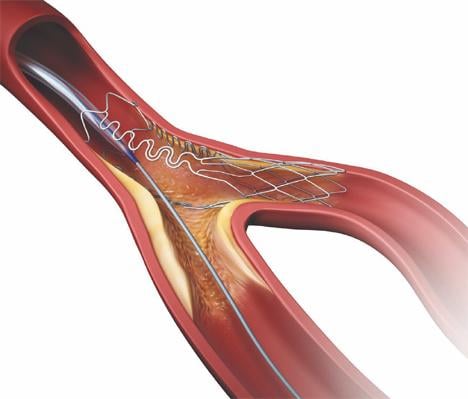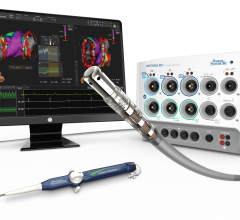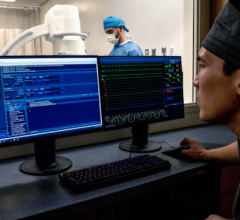September 17, 2009 – One of the activities at TCT 2009 is the Hearts in Hand Collection, a library of physical heart models in a variety of structural disease states, which allow physicians to gain quick and thorough understanding of spatial relationships and practice catheter pathways and device sizing prior to conducting minimally invasive interventions.

According to the American Heart Association (AHA), arrhythmias afflict more than 4 million patients and results in approximately half a million deaths each year in the United States. Electrocardiography (ECG) measurements, which record and interpret cardiac electrical activity over time, are widely used to detect abnormal heart rhythms.
A 55-year-old woman with a history of heavy alcohol use, hepatitis C induced cirrhosis, hypertension, and chronic renal insufficiency presented at Massachusetts General Hospital in Boston Mass., with nine months of increasing intermittent substernal chest pressure. The pain was inducible by exertion, was nonradiating, and when present associated with shortness of breath, and diaphoresis.
Providing exceptional cardiovascular care for patients to achieve the best possible outcomes is the number one goal for ...

In August Daiichi Sankyo and Eli Lilly and Company launched U.S. sales of Effient (prasugrel), a new antiplatelet medication to prevent stent thrombosis, which clinical studies show to be more effective and better tolerated than Plavix (clopidogrel).

Ruptured vulnerable plaque (VP) is blamed for the majority of acute myocardial infarctions and many strokes, but there is extensive debate over which modalities are best suited to detect these plaques, and there is as of yet no conclusive way to determine which of these plaques will rupture.

Stenting of lesions at coronary vessel bifurcations is one of the most challenging percutaneous interventions, along with a high risk of procedural complications and restenosis. Several companies are developing specialized bifurcation stents to help make the job easier. Currently there are no dedicated bifurcation stents with FDA clearance.
Cardiac positron emission tomography (PET) is growing in popularity among cardiologists because it provides the ability ...
September 17, 2009 - Inflation rates for healthcare supplies are projected to remain unchanged through 2010, according to an analysis released by the Premier healthcare alliance.

Over the past year several new drug-eluting stents (DES) stents have been released and SYNTAX trial data proved DES compare as well as coronary artery bypass graft surgery (CABG) in patient outcomes. DES vs. CABG

Metal stents are foreign objects that can irritate vessels and cause stent thrombosis, prevent vessel remodeling, prevent future surgical interventions, can fatique and suffer strut fractures, and impair CT or MR imaging. For these reasons several stent manufacturers are working on biodegradeble stents that do not leave behind any hardware.
When performing radiofrequency (RF) ablation to treat cardiac arrhythmia, medical professionals must balance the safety ...
September 17, 2009 - The Senate Finance Committee reduced the imaging utilization assumption rate from 90 percent to 65 percent, in essence cutting the originally proposed utilization increase by nearly two-thirds.
September 17, 2009 - Lantheus Medical Imaging Inc. today announced the initiation of a Phase 1 clinical study to assess the safety, dosimetry and tolerability of LMI1195, a novel F-18 small molecule tracer for imaging cardiac neuronal function, in healthy subjects, undergoing positron emission tomography (PET) imaging.

The polymer coating on drug-eluting stents (DES) used to carry the antiproliferative drugs cause an increased risk of stent thrombosis, months or even years after a stent is implanted. This has led stent manufacturers to look for or ways to eliminate the vessel irritating polymers for better biocompatibility usually associated with bare metal stents (BMS).
Change Healthcare Cardiology Hemodynamics is an integrated hemodynamic monitoring system for monitoring vital signs and ...
September 16, 2009 – Guided Delivery Systems Inc. (GDS) announced the first successful percutaneous implantation of the GDS Accucinch System for mitral valve repair.
September 16, 2009 - Medrad will host a breakfast symposium, “Complete Thrombus Management During Rapid STEMI Intervention,” during TCT 2009, starting at 6:30 a.m. Thursday, Sept. 24, in Moscone Center, room 130.
September 16, 2009 – Texas Cardiac Arrhythmia Institute at St. David’s Medical Center in Austin, Texas plans to create a worldwide electrophysiology (EP) telecardiology network for live consultations with other EP labs anywhere in the world using the Odyssey Network offered by Stereotaxis.

 September 17, 2009
September 17, 2009










